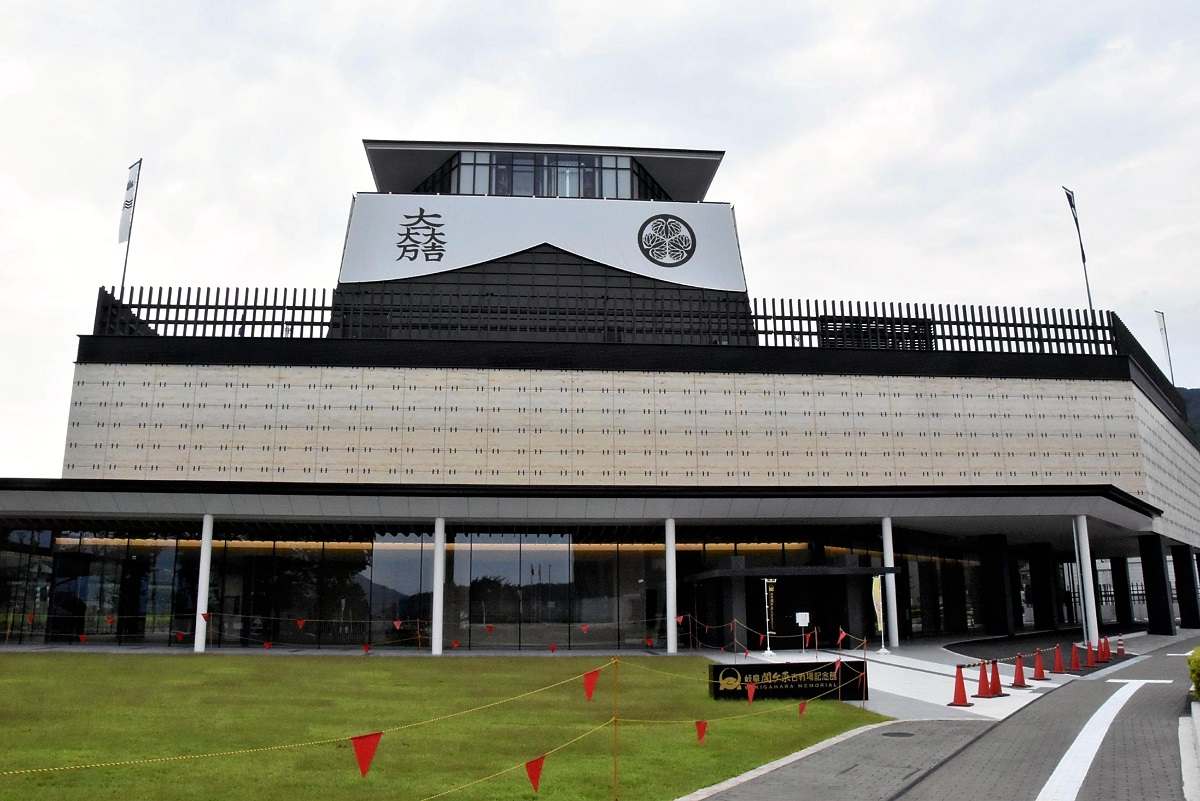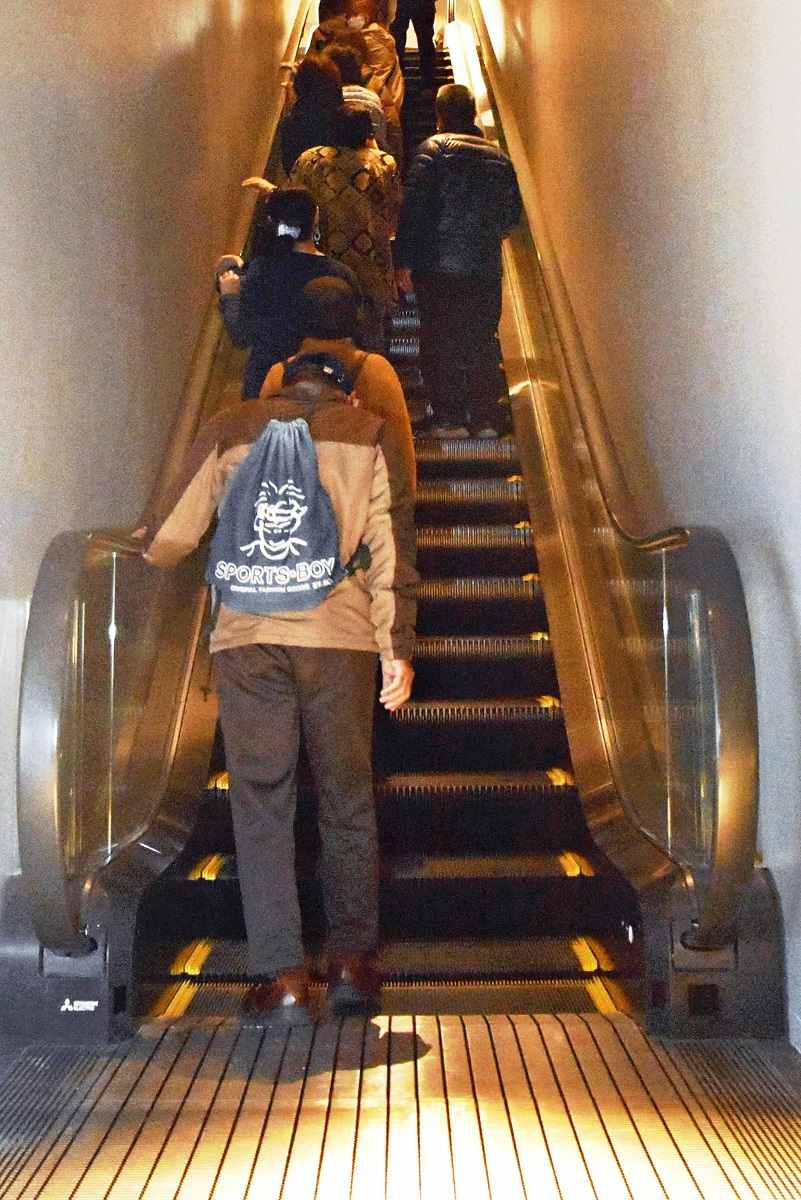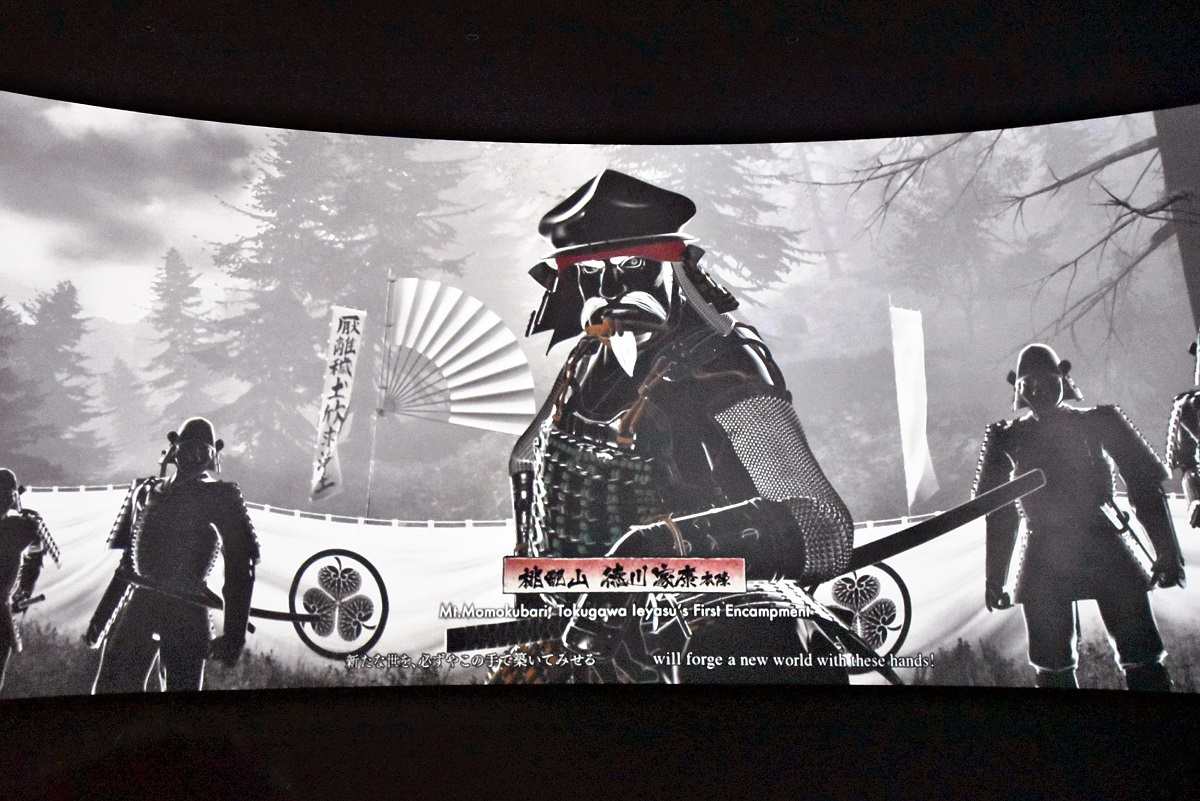
People ride the escalator with left side open in Kita Ward, Osaka, left photo, and with right side open in Minato Ward, Tokyo.
18:05 JST, February 26, 2021
SEKIGAHARA, Gifu — Escalator etiquette varies across Japan. In eastern areas such as Tokyo, people usually stand on the left to allow people in a hurry to pass on the right. The opposite applies in Osaka and other western cities, where people tend to stick to the right, and leave the left side open.
A search to pinpoint the dividing line led me to Sekigahara, a town in Gifu Prefecture which received its first public escalator with the opening of the Gifu Sekigahara Battlefield Memorial Museum in October last year.
More than just an escalator, I found the addition to be a symbolic new front in the culture wars that quietly converge in this town with a long history of blurring the east-west divide.

The Gifu Sekigahara Battlefield Memorial Museum is seen in Sekigahara, Gifu Prefecture.
Crossroads of east and west
Sekigahara is famously known as the scene of the epic Battle of Sekigahara in 1600 between an eastern army loyal to Tokugawa Ieyasu and the western forces of Toyotomi Hideyoshi, who had died two years earlier. The battle is often considered one of the turning points that marked the start of the Tokugawa shogunate.
Nestled near the center of Honshu, the town is still said to be a sort of porous border where the customs of East Japan meet those of West Japan in a cultural tug-of-war that even plays out in the town’s kitchens. Bonito broth, commonly used in eastern Japan, is more frequently found in dishes on the area east of Sekigahara, while western-favored kombu-broth dishes are more likely to be on offer across town.
Escalators can be another point of cultural contention. Residents of Ogaki, a city to Sekigahara’s east, had been observed standing on the left, and it was common knowledge that locals in Maibara, the town’s western neighbor in Shiga Prefecture, tend to line up on the right.
But nobody was quite sure where Sekigahara’s loyalties aligned over moving staircases.
As a municipal government official explained, “There weren’t any public escalators in Sekigahara.”
However, the Gifu Sekigahara Battlefield Memorial Museum that opened last October is equipped with what is believed to be the town’s first public escalator, making it possible to settle once and for all how the town sides.

People ride what is believed to be the first public escalator in town in Sekigahara, Gifu Prefecture.
Left with more questions
The new, 14-meter-long escalator is wide enough to carry two rows of visitors standing sidebyside from the museum’s first to second floors.
Over four consecutive hours, I counted 212 riders. Subtracting those visitors who boarded the escalator shoulder to shoulder, there were 134 riders who chose to ride on either the right or left. By my tally, 116 people stood on the left, over six times more than the 18 who stood on the right.
When asked what influenced the decision to pick one side over the other, a woman in her 60s from Sekigahara said, “I typically get around by car, so it’s natural to keep to the left [like on the road].” Meanwhile, a man in his 60s from Osaka Prefecture said, “I suppose I instinctively moved to the right.”
As the museum receives a wide range of tourists from both within and outside the prefecture, particularly from Aichi Prefecture to the left-inclined east, it is difficult to say whether my sample was truly representative of local trends. It seemed my attempt to get a firm grasp on Sekigahara was only leaving me with a head full of follow-up questions.
Why left in Tokyo, right in Osaka?
Kazuyoshi Maegaki, a visiting professor at Soai University’s Faculty of Humanities, attributed the custom in western Japan to a Hankyu Railway announcement.
According to Maegaki, who researches Osaka’s regional culture, when Hankyu Corp. installed an escalator as part of the expansion of Umeda Station in Osaka City in 1967, the company played an announcement asking people to stand on the right side, so the left could remain clear for travelers in a hurry.
This announcement is believed to have initiated the gradual spread of escalator riders in western Japan standing on the right.
But why did the company urge people to stand on the right?
Maegaki speculates that since most people are right-handed, standing to the right would make it easier to grab onto the handrail.
If that’s the case, then why do people in eastern Japan stand to the escalator’s left?
The practice may have something to do with the Allied occupation of Japan after World War II. Maegaki said that GHQ codified a road rule that said the right-hand lane should be used when overtaking other traffic. This notion of passing on the right presumably spread from Tokyo throughout eastern Japan.
No need to leave one side open
In recent years, a growing new consensus encourages riders to stand anywhere they want, right or left.
An official with the Japan Elevator Association, which has jurisdiction over escalators, said: “Let’s remember there are some people with disabilities, who can’t necessarily use a particular arm. You’re free to stand on either side you prefer, but we ask that you always hold onto the handrail.”
The same opinion has been spreading among railroad operators and commercial facilities across the country, with increasing requests for escalator riders to remain standing while grabbing onto the belt.
“You don’t have to leave one side open [to walkers], as walking on the escalators can cause accidents,” an official said.

An animated video of the Battle of Sekigahara is shown onscreen.
Virtual battle experience
The Gifu Sekigahara Battlefield Memorial Museum is a facility run by the Gifu prefectural government that showcases the Battle of Sekigahara through special movies and exhibits.
The museum opened last October in the town of Sekigahara, where the historic battle took place in 1600.
The facility has five floors. On the first floor, visitors can experience the battle virtually in an exhibit that pits vast animated armies against each other, projected on a 4.5-meter-high and 13-meter-wide screen.
The animation unfolds from the point of view of a soldier who participated in the battle. Wind blows and the seats sway in time with the movie, creating an immersive, realistic illusion that you’re there with the soldiers on the battlefield.
The Ground Vision theater, which projects videos on a screen on the floor, provides a panoramic view of the battle between the East and West camps.
On the museum’s second floor, there is an exhibition room outfitted with armor from the Sengoku “Warring States” period, where you can also experience a one-on-one battle between warlords in virtual reality.
Reservations are required. Admission is ¥500 for adults, ¥300 for university and high school students, and free for junior high school students and younger. Open from 9:30 a.m. to 5 p.m. Closed on Mondays.
Related Tags
"Features" POPULAR ARTICLE
-

Sanrio to Open Museum in Yamanashi Pref. Dedicated to Founder, Exhibits Include Hello Kitty, Other Characters
-

Autumn Foliage Surrounds Visitors to Tokyo’s Showa Kinen Park
-

My Daughter No Longer Speaks to Me, But I Want to See Her and My Grandchild
-

Kumamoto: Public Bath Refurbished as Library Where You Can Chat, Take Photos
-

Frozen Vegetables: Demand Rises for Convenient, Tasty Domestic Produce
JN ACCESS RANKING
-

Tokyo Economic Security Forum to Hold Inaugural Meeting Amid Tense Global Environment
-

Keidanren Chairman Yoshinobu Tsutsui Visits Kashiwazaki-Kariwa Nuclear Power Plant; Inspects New Emergency Safety System
-

Imports of Rare Earths from China Facing Delays, May Be Caused by Deterioration of Japan-China Relations
-

University of Tokyo Professor Discusses Japanese Economic Security in Interview Ahead of Forum
-

Japan Pulls out of Vietnam Nuclear Project, Complicating Hanoi’s Power Plans

























